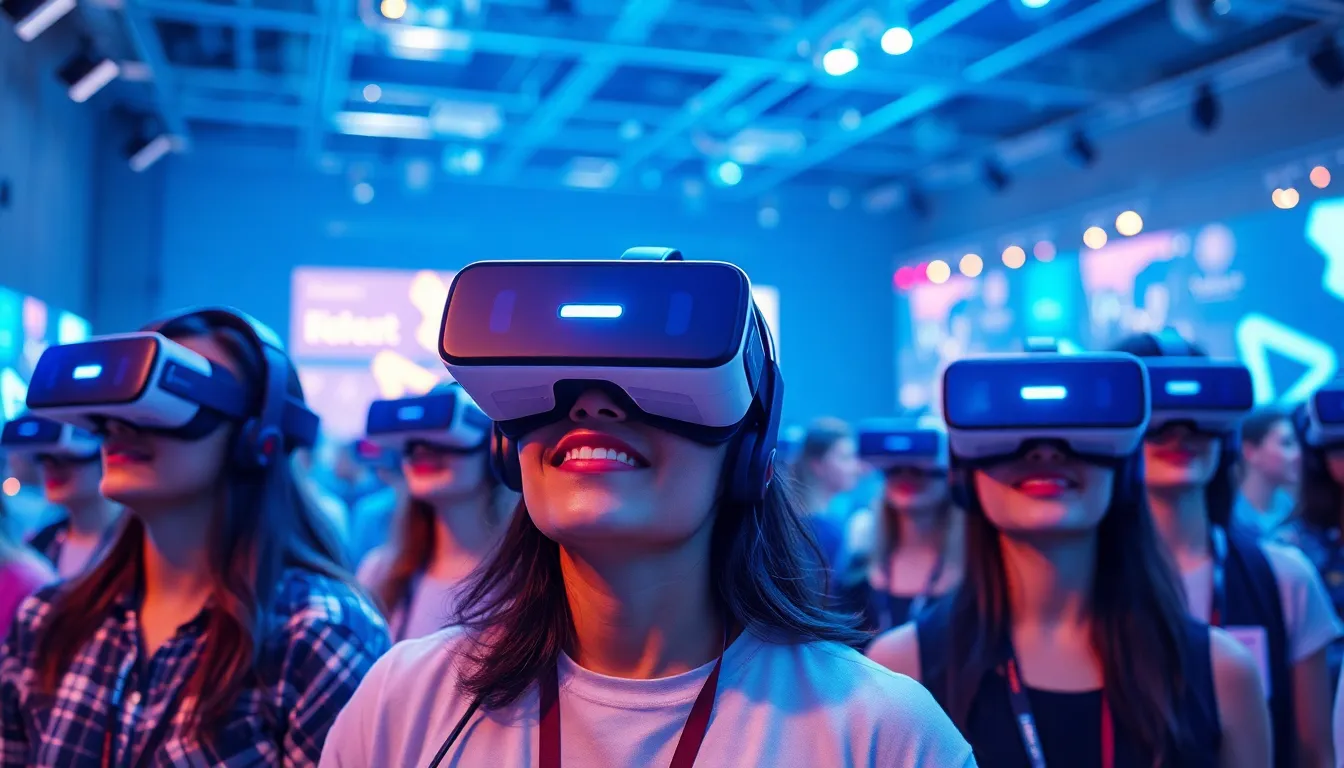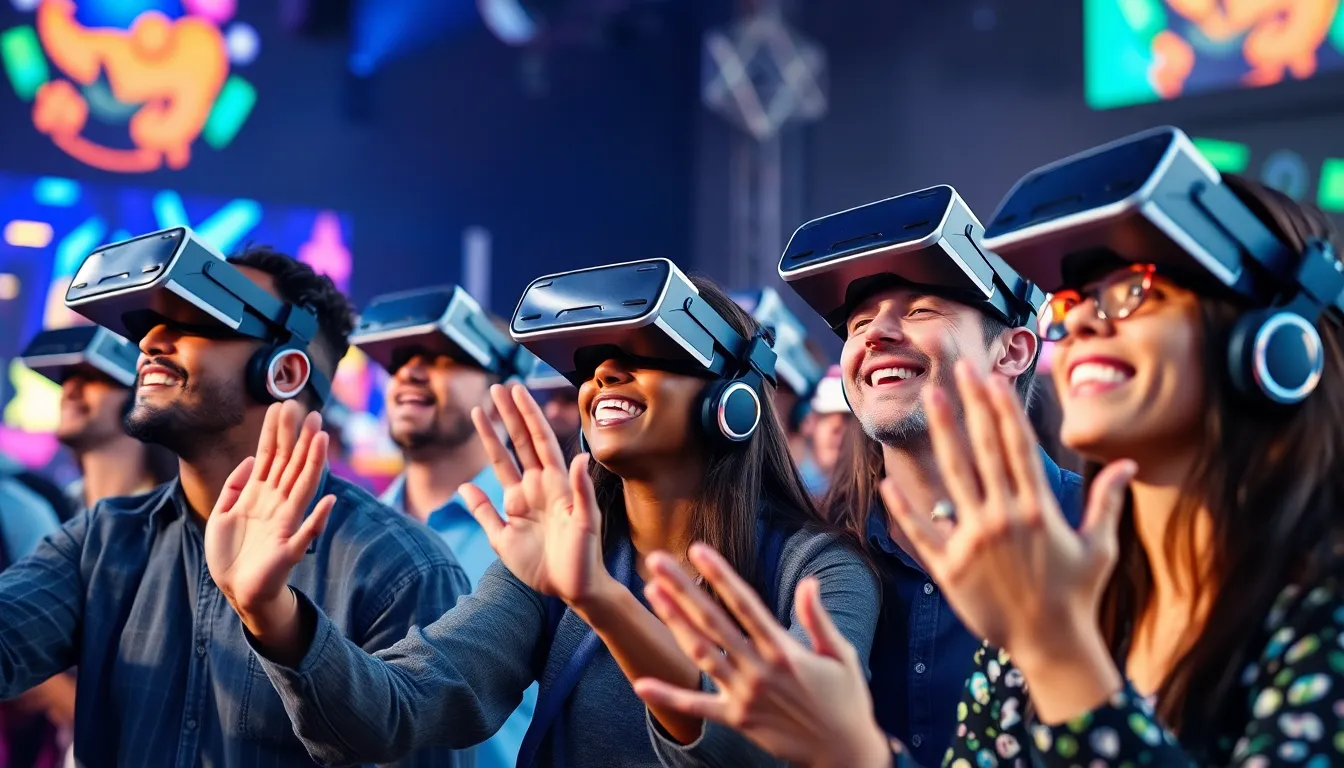Imagine slipping on a VR headset and finding yourself front row at a concert without the hassle of traffic or overpriced popcorn. Live-streamed VR events are revolutionizing how people experience entertainment, blending the thrill of in-person events with the comfort of home. Whether it’s a music festival, a thrilling esports competition, or an interactive theater performance, these virtual experiences are making waves in the entertainment industry.
Table of Contents
ToggleOverview of Live-Streamed VR Events
Live-streamed virtual reality events provide immersive experiences for a global audience. These events encompass various forms of entertainment, including concerts, esports competitions, music festivals, and interactive theater performances. Audiences enjoy the thrill of participating from their own homes, eliminating the hassle of travel and associated costs.
Many platforms host live-streamed VR events, enhancing user engagement through interactive features. Participants interact with performers and other viewers in real-time, creating a sense of community and shared experience. The integration of advanced VR technology ensures high-quality visuals and sound, amplifying user immersion.
Streaming capabilities enable broad accessibility, reaching viewers who may not attend in-person events. Users with VR headsets experience enhanced visual depth, while those without can still participate through standard devices. This flexibility caters to a variety of audience preferences, maximizing attendance rates.
Commercial aspects also contribute to the growth of live-streamed VR events. Brands leverage these platforms for marketing opportunities, offering exclusive content and experiences to enhance audience interaction. Sponsorships from major companies further support the financial viability of these events.
Recent studies indicate that engagement levels in live-streamed VR events surpass traditional formats. Attendees report higher satisfaction rates due to the unique, immersive interactions available. With the rapid development of VR technology, the potential for future live-streamed events continues to expand, promising an exciting landscape for both creators and audiences.
Benefits of Live-Streamed VR Events

Live-streamed VR events present numerous advantages that enhance participant engagement and widen reach.
Enhanced User Experience
Immersive environments create memorable moments for attendees. Advanced VR technology enables stunning visuals and spatial audio, making events feel lifelike. Interaction features allow users to communicate with performers and other viewers. Social dynamics deepen as participants share experiences in real-time. This unique environment encourages active participation rather than passive observation. Customized avatars offer personalized connections, enhancing overall satisfaction. Studies indicate these elements contribute to higher attendee retention rates compared to traditional events.
Accessibility for Global Audiences
Global audiences can access live-streamed VR events regardless of location. VR headsets deliver high-quality experiences, while standard devices provide alternate routes for participation. Accessibility eliminates geographical barriers, allowing anyone with an internet connection to join. Language options expand audience demographics, making events inclusive. Limited ticket availability becomes less of a concern, increasing potential attendance. Brands also benefit from broader marketing reach while engaging diverse viewer bases. The flexibility inherent in these events ensures maximum participation levels across various platforms.
Challenges of Live-Streamed VR Events
Live-streamed VR events face several challenges that can affect their overall success. Addressing these challenges requires thoughtful strategies.
Technical Limitations
Technical limitations frequently hinder the experience of live-streamed VR events. Connectivity issues can disrupt streaming quality, leading to lag or pixelation. Bandwidth constraints limit the number of simultaneous users without degrading performance. Hardware requirements also restrict access; not all users possess the latest VR headsets. Integration of various devices sometimes results in inconsistent user experiences. Ensuring a smooth experience necessitates testing and optimization across different platforms. Event organizers need to account for these factors to enhance user engagement.
Engagement and Interaction
Engagement and interaction present notable challenges for live-streamed VR events. Users may struggle to connect with one another in virtual environments. Meanwhile, the lack of spontaneous interactions diminishes the feeling of presence. Retaining audience interest can become difficult without compelling content and interactive elements. Event designers often rely on innovative features to encourage participation. Customization options for avatars enhance personal connections, but not all participants may take advantage of these features. Crafting engaging narratives helps to maintain user attention throughout the event. Addressing these challenges fosters a more immersive and interactive experience.
Popular Platforms for Live-Streamed VR Events
Various platforms facilitate live-streamed VR events, each offering unique features. Platforms such as AltspaceVR provide a social environment where users can attend events, engage with others, and interact with performers. This platform often hosts concerts and meet-ups, making it a popular choice for community-driven experiences.
VRChat stands out due to its focus on user-generated content. Users can create and share their own environments, enabling a wide range of events from dance parties to educational seminars. Engagement in VRChat can lead to a more personalized experience, allowing attendees to form connections with others in their custom spaces.
Another option, Somnium Space, emphasizes a blockchain-based economy. This platform integrates NFTs into events, offering users unique digital assets associated with their experiences. This approach not only enhances the event but also introduces new economic possibilities for creators and attendees alike.
Rec Room shines in providing a casual atmosphere for diverse activities. Users can play games, attend live shows, or participate in creative gatherings within their virtual rooms. The platform is particularly appealing to younger audiences, showcasing a blend of gaming and social interaction.
Facebook Horizon aims to provide a social VR experience. Built by Meta, this platform allows users to create avatars, chat, and participate in events like concerts and festivals. Despite being relatively new, it has quickly gained traction among users who seek an interactive social environment.
Finally, YouTube VR offers a more traditional streaming experience. While lacking immersive interaction, it allows users to view live-streamed events in a VR setting, making it accessible to a broader audience. This combination of platforms indicates an expanding landscape for live-streamed VR events, highlighting the importance of choosing the right venue for creators and attendees.
Future Trends in Live-Streamed VR Events
Emerging technologies will continue shaping live-streamed VR events. Increased use of artificial intelligence enhances personalization. AI-driven recommendations improve content discovery during events, making the experience more tailored for users. Virtual and augmented reality integration opens new realms for audience interaction. Users may expect augmented elements overlaying real-world environments during live-streamed events.
Advanced social features are on the rise as platforms adapt to community needs. More users engage through chat, reactions, and live polls, creating interactive atmospheres. Event organizers can leverage these tools to boost participation, fostering deeper connections among attendees. Gamification elements will attract younger users, providing incentives for engagement.
Edge computing will reduce latency in VR experiences, offering real-time interactions. Fast connections will also allow for more seamless transitions between different event segments, enhancing overall quality. Security advancements become essential as live-streamed events attract larger audiences, which could lead to data privacy concerns.
New monetization strategies will emerge, including subscription models and pay-per-access. Brands may explore partnerships with artists for exclusive content. Diverse revenue streams allow creators to sustain future events and grow audiences.
Sustainable event planning will gain traction amidst growing environmental concerns. Companies will focus on reducing carbon footprints through virtual alternatives. This shift positions VR events as eco-friendly options, appealing to environmentally conscious consumers.
Broadening accessibility remains crucial, as more people can participate through improved device compatibility. Streamlined experiences will cater to newcomers, enabling wider reach. Accessibility initiatives will ensure that diverse demographics can enjoy live-streamed VR events.
Live-streamed VR events are reshaping the entertainment landscape by offering immersive experiences that transcend geographical boundaries. As technology continues to advance, these events are set to become even more engaging and accessible. The blend of high-quality visuals with interactive features fosters a sense of community among participants, enhancing overall enjoyment.
While challenges remain in terms of technical limitations and user engagement, the potential for innovation is vast. Creators and brands can leverage these developments to connect with wider audiences, creating memorable experiences that resonate. As live-streamed VR events evolve, they promise to redefine how audiences experience entertainment in the digital age.

